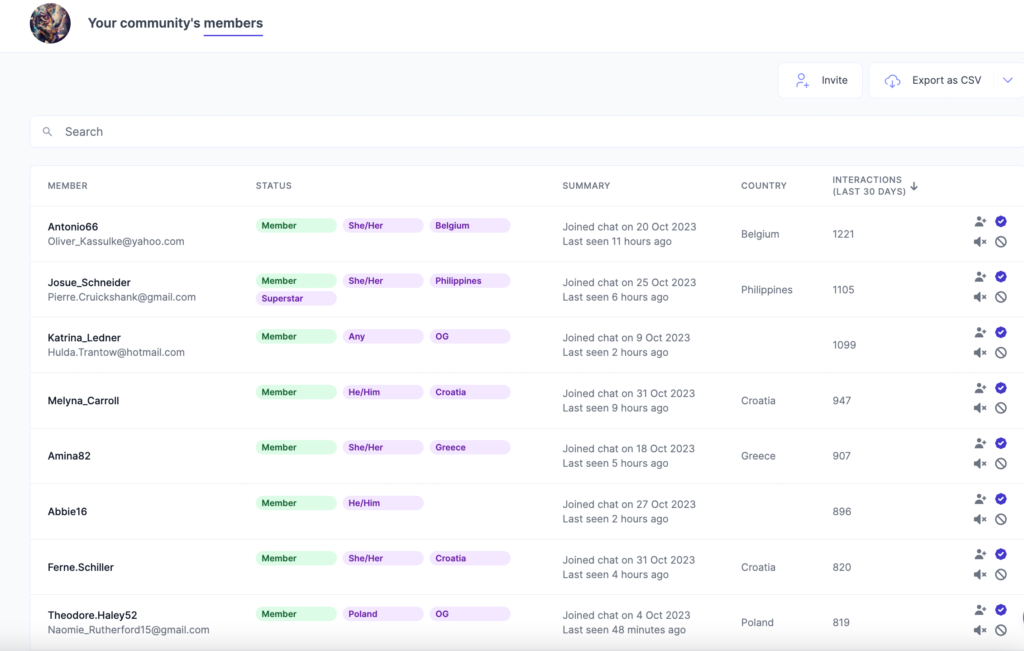One of the biggest challenges in building community is understanding what success looks like. How do you measure whether your brand’s relationship with fans is happy and healthy?
Happily, it’s not only possible to quantify that relationship – it’s crucial to do so. Building a thriving community on Discord requires a strategic approach, which must be informed by data insights to achieve tangible results for your brand. That’s one of the major advantages of a Discord community over social media: Discord is a treasure trove of rich and nuanced data analytics, which helps you understand your community and strategise accordingly.
Brands in any vertical can take advantage of this data to build an emotional connection with fans and drive value. Huge names in music, gaming, sports and more are already fostering deeper connections with their fans – even major global brands like Starbucks.
Let’s explore a framework of key metrics that help you define and measure the success of your community. These KPIs are your guides as you set your targets, identify opportunities and achieve successful ROI in marketing and monetisation.
1. Community participation rate (CPR)
CPR measures how engaged your community is, similar to engagement rate on social media. Your server’s community participation rate is the percentage of members actively participating in discussions, events, and activities. Even the most thriving communities will experience ups and downs in CPR. That’s why it’s essential to have a dedicated team to keep an eye on CPR week-to-week, focusing on positive growth – especially during key activation moments. A healthy community should see incremental improvements in engagement over time, indicating that more members are moving from passive lurkers to active participants.
Your goal: Achieve a CPR over the industry standard of 10%. This means at least 10% of your community members should be actively and regularly engaging with content.
Participation key metrics:
- Number of messages sent per user, per month
- Number of members participating in events or discussions
- Growth in the percentage of active users over time
2. Audience growth
The community should be constantly growing. Even if that audience growth is minimal, your server should always be attracting new fans who are interested in engaging on a deeper level than they can on other platforms.
Your goal: An expanding community. Deploy proven growth strategies and track monthly audience growth – even small, consistent increase is a positive indicator.
Growth key metrics:
- New members joining each month
- Retention rate of new members after their first month
- Referral or word-of-mouth growth (members inviting others)
3. Majority of the audience as ‘active participants’
A successful community should have more than 50% of its members classified as “active users”, who contribute regularly to discussions and events, moving beyond passive observation and contributing to the server’s life.
Your goal: Ensure that over half of your community is active, by deploying engagement strategies.
Activity key metrics:
- Percentage of users who engage in the community at least once a week
- Users participating in at least one event or conversation per month

4. Active users returning to the server weekly
Active users should be returning to the Discord server at least weekly, demonstrating ongoing interest and connection with the community. From the moment they sign up, they should be incentivised to keep coming back.
Your goal: Foster habits among members that encourage fans to check in and engage with the community on a regular basis.
Returning key metrics:
- Weekly active users (WAU)
- Recurrence rate (how often users return after their first visit)
- Bounce rate (how many users visit but do not return)
5. Alignment with overall goals/KPIs
The success of the community should be directly linked to your broader brand and career goals. For a music artist or label, that could mean increasing streaming numbers, boosting merch sales, and selling out tour tickets. For a gaming brand, that could mean increasing game sales and encouraging players to play more. For a sports team, that could mean merch sales, signing up to streaming services and watching games, and attending matches.
Your goal: Ensure that community activities and engagement strategies are aligned with and support your overarching KPIs, in marketing and monetisation or both.
Goals key metrics:
- Engagement with third-party integrations eg increasing Spotify streaming by Discord members
- Ticket sales through community-exclusive offers or presales
6. Added value
The community should offer unique value that cannot be found on other social platforms, which are often more about broadcasting content than true engagement. Fans love awesome perks, XP and rewards – and they come back for stuff they can’t get anywhere else.
Your goal: Create experiences, conversations, connections and exclusive content that fans can only access through your Discord community. This could include:
- Exclusive content (eg behind-the-scenes, early releases, teasers)
- Direct interactions with the artist (eg AMAs, live chats)
- Unique perks (eg community-only merch, fan contests)
- Fan input (eg voting on artwork, merch designs or set lists)
Value key metrics:
- Engagement rates on exclusive content
- Feedback from members on the value of exclusive offerings
- Participation rates in community-specific events and fan input activations
7. IRL meetups
IRL meetups are a great sign that your community is thriving, as they demonstrate that fans are forming real friendships with each other that go beyond the digital world. To ensure fan safety, these events should be organised by the artist’s team, with official representatives present.
Your goal: Cultivate a community culture that encourages in-person meetups, but ensure they are team-organised to provide a safe and structured environment for fans to connect and build relationships.
Meetups key metrics:
- Number of IRL meetups organised by the team
- Attendance at official IRL events or meetups
- Feedback from attendees on the quality and value of these meetups
8. Relationships and trust
A thriving community is fundamentally built on relationships, both between the artist and the fans, and among the fans themselves. Trust is crucial to building a thriving community, so it’s vital to quantify this relationship.
Your goal: Prioritise relationship-building activities and strategies, understanding that community growth and engagement take time. Strategies include:
- Habitual systems that keep bringing fans back to engage, week after week
- Communal activities, such as playlists that fans can contribute to and come back to
- Regular community-led online events
Trust key metrics:
- Sentiment analysis of community discussions (positive vs. negative interactions)
- Long-term retention rates of highly active users
- Anecdotal evidence of strong connections (eg testimonials from members)
Take the next step
Here at Levellr, we help clients like Fall Out Boy and Starbucks engage fans and loyal customers, turning happy and healthy Discord communities into tangible marketing and monetisation results.
To see how it works, check out our YouTube playlist of handy video guides or read more about how a Discord community can help you smash your brand goals.
Contact Levellr today to find out how you can build, maintain and grow a happy and healthy community – by any measure.

